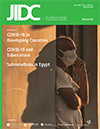One-step nested RT-PCR for COVID-19 detection: A flexible, locally developed test for SARS-CoV2 nucleic acid detection
DOI:
https://doi.org/10.3855/jidc.12726Keywords:
SARS coronavirus, DNA Synthesis, Pandemics, DNA electrophoresisAbstract
Introduction: Due to the coronavirus pandemic, identifying the infected individuals has become key to limiting its spread. Virus nucleic acid real-time RT-PCR testing has become the current standard diagnostic method but high demand could lead to shortages. Therefore, we propose a detection strategy using a one-step nested RT-PCR.
Methodology: The nucleotide region in the ORF1ab gene that has the greatest differences between the human coronavirus and the bat coronavirus was selected. Primers were designed after that sequence. All diagnostic primers are species-specific since the 3´ end of the sequence differs from that of other species. A primer set also creates a synthetic positive control. Amplified products were seen in a 2.5% agarose gel, as well as in an SYBR Green-Based Real-Time RT-PCR.
Results: Amplification was achieved for the positive control and specific regions in both techniques.
Conclusions: This new technique is flexible and easy to implement. It does not require a real-time thermocycler and can be interpreted in agarose gels, as well as adapted to quantify the viral genome. It has the advantage that if the coronavirus mutates in one of the key amplification nucleotides, at least one pair can still amplify, thanks to the four diagnostic primers.
Downloads
Published
How to Cite
Issue
Section
License
Authors who publish with this journal agree to the following terms:
- Authors retain copyright and grant the journal right of first publication with the work simultaneously licensed under a Creative Commons Attribution License that allows others to share the work with an acknowledgement of the work's authorship and initial publication in this journal.
- Authors are able to enter into separate, additional contractual arrangements for the non-exclusive distribution of the journal's published version of the work (e.g., post it to an institutional repository or publish it in a book), with an acknowledgement of its initial publication in this journal.
- Authors are permitted and encouraged to post their work online (e.g., in institutional repositories or on their website) prior to and during the submission process, as it can lead to productive exchanges, as well as earlier and greater citation of published work (See The Effect of Open Access).








